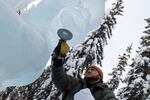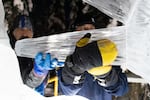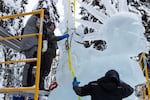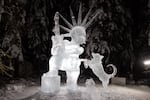A 13-foot baby made of ice stood half-finished in a clearing surrounded by snow-covered pines.
Unfazed by the 10-degree temperature, professional sculptor Chris Foltz stepped into the loader bucket of a bulldozer, which he used as a makeshift elevator to access the top half of the sculpture. Inside the bucket were five ice spikes, each roughly the length of a parking meter and weighing around 120 pounds. Foltz planned on attaching the spikes to the baby’s head.
“We’re putting a mohawk on a baby,” Foltz said. “That’s what we’re about to do.”
Every February in Fairbanks, Alaska, the World Ice Art Championships, also known as Ice Alaska, hosts the most talented sculptors from across the globe. The competition is widely regarded as one of the largest and most renowned ice sculpting events worldwide, and the freezing temperatures in Alaska provide the perfect environment for sculpting ice. In February, Foltz led a team from Oregon that was hoping to win it all.
“You’re looking through the forest and you’re seeing these master artists from all different walks of life,” he said. “It became gripping to realize that I could be there with these people in this arena. It is amazing. It’s an amazing place to be.”
Foltz and his team were competing for his eighth world championship in Ice Alaska’s flagship event, the multiblock competition, where teams are given nearly a week to carve a sculpture using up to nine 2,000-pound blocks of ice. There are no restrictions on the type of sculptures that can be built, so artists have full creative freedom.
“Ice Alaska has no theme or direction,” he said. “Which is really cool for people like me because I just love carving stuff that I’ve never seen before or I think I’ll never see again.”

Chris Foltz takes a moment to admire his creation in Fairbanks, Alaska, in February.
Noah Thomas / OPB
The wild child
The sculpture grounds at Ice Alaska are nestled in the woods, covering a space roughly the size of a soccer field. A looping pathway branches off into various cul-de-sacs revealing ice sculptures in various forms, ranging from historical figures to fictional creatures. And of course this year there was Foltz’s giant punk rock baby nicknamed “wild child.”
Foltz got the idea for the sculpture while listening to Iggy Pop’s “Real Wild Child” during a late-night drive.
“I was making an ice delivery outside of Salem, and the idea of this giant baby with a mohawk came into my mind,” he said. “If I was a bronze sculptor I’d need something a little more serious but it’s not like it’s going to be there very long. It’s going to melt.”
Though Foltz conceived the idea for the sculpture, bringing it to life was a collaborative effort. His team had four members: Foltz himself, along with experienced sculptors Dean Murray and Dean DeMarais. Murray, an award-winning sculptor in his own right, is the one who first brought Foltz to Ice Alaska.
“It didn’t take long for the student to become the master and surpass me,” Murray said. “I think he’s a better all-around sculptor than me, but I don’t think he’s beat me in a head-to-head competition yet.”

Nicolas Graham smooths out an ice sculpture with a sander in Fairbanks, Alaska.
Noah Thomas / OPB
Joining them was Nicolas Graham, a newcomer to the ice sculpting scene. While Murray and DeMarais had participated in numerous Ice Alaska competitions, Graham’s experience was limited to college-level sculpting contests, the equivalent of the minor leagues of ice sculpting.
This year, seven teams participated in the multiblock event, and the competition was stiff. Sculptors often work morning and night to take advantage of every minute they have. While the process can be arduous, Foltz said he appreciates the camaraderie that develops between him and his teammates.
“It’s good energy,” Foltz said. “It’s like visiting your family every time you come up here.”
The stack
During the initial days of the competition, Foltz and his team employed a technique called stacking. They strategically assembled blocks in the rough shape of the baby and slowly carved out the details. On day four, Foltz examined a diagram containing the various components that would make up the finished sculpture.
“These are all the pieces that’ll be added,” he said. “We’re going to have baby blocks, we’ve got a binky, we’ve got a couple of safety pins, and then it’ll be playing the toy guitar.”
Ice Alaska employs volunteer bulldozer and crane operators to help position the humongous ice carvings into place, and sculptors take full advantage of this privilege.
After positioning the mohawk spikes in the bulldozer’s loader bucket, Foltz stepped inside to hitch a ride. The baby was now close to two stories tall and the team erected a scaffolding to work on its top half.

(from left) Dean DeMarais and Chris Foltz attach a mohawk spike made of ice in the 2023 World Ice Art Championships in Fairbanks, Alaska.
Noah Thomas / OPB
Attaching the spikes is a three-man effort. Foltz and Murray slowly position the spike in place while Graham focuses on bonding it to the head using partially melted snow, or slush. In single-digit temperatures, the slush freezes within minutes creating an incredibly strong bond. This simple process of lifting, positioning, and slushing is a fundamental aspect of ice sculpting.
“Usually your artwork is either subtractive or additive,” Foltz said. “So either you’re adding clay or you’re subtracting from stone. Ice carving is both. You have all these blocks that you need to build, so your structure is additive, and then you move to a subtractive nature where you’re actually sculpting kind of like stone.”
The guitar
After attaching the mohawk spikes to the baby’s head, the team prepared for the most challenging stage of the build: mounting a 1,500-pound guitar. As it was, the baby looked like it was playing an air guitar. The team had to lift the hefty ice guitar — sculpted in the days prior — off the ground and carefully position it in the baby’s arms.
“This is probably the most intricate part,” Foltz said. “So we’ll see how it goes.”
DeMarais assisted the crane operator with strapping in the guitar and attaching it to the crane hook. Once lifted off the ground DeMarais meticulously guided the crane operator using mostly hand gestures. The guitar soon dangled right beside the baby, and all four team members helped to guide it in place.
“Steady. Steady,” Foltz instructs. “Okay, can you guys pull your side out a little bit?”
They had the guitar positioned almost exactly where they wanted it when suddenly it slipped, and a loud crash ensued. The guitar stem knocked off one of the mohawk spikes and the right hand of the baby. Fortunately, the crane was bearing the majority of the weight, mitigating the potential for a more significant catastrophe.

(from left) Dean Murray, Nicolas Graham, and Dean DeMarais position an ice guitar in Fairbanks, Alaska.
Noah Thomas / OPB
The team quickly re-oriented themselves and successfully got the guitar mounted. Once the crane was detached and everyone was safely on the ground there was a collective sigh of relief.
“So we had the arm snap at the elbow and luckily no one got hurt,” Graham said. “I just got skimmed on the side of my head and got a little rattled. That’s the first time I’ve experienced a crash.”
The other team members have experienced many crashes throughout the years and understand that accidents like this are just part of the process.
“Ice breaks,” Foltz said. “I want you to lodge that into your mind. Once you have that, you’ll know you can fix anything. But don’t ever imagine ice is not going to break.”
The final day
On the last day of the multiblock competition, the excitement was palpable as teams hustled to finish their sculptures.
“We’ve got about eight hours left,” Foltz said. “Super ready for the finish line. We’ve been averaging 12-hour days. We’re looking at coming up on that 70-80 hour mark for the full piece.”
Over the past several days, DeMarais has been hard at work carving a 9-foot-tall Chihuahua. Now, the team’s primary focus was positioning the dog right next to the baby.
“You can see the dog’s basically vertical right now,” Foltz said. “But we’re going to set it so it’s leaning up against the baby.”
They enlisted the help of a crane operator to lift the giant ice dog and move it in front of the baby. The dog was significantly larger than the guitar, but since it was remaining on the ground, the process was much less cumbersome.
After Foltz and DeMarais successfully moved the dog into place, the team got started on detail work like placing spikes on the dog’s collar, making a safety pin for the baby’s diaper, and carving toy blocks.
“It’s been a really productive day, honestly,” Graham said. “A lot smoother than I thought it was going to be.”

Photo of "The Wild Child" ice sculpture taken in February at the World Ice Art Championships in Fairbanks, Alaska.
Noah Thomas / OPB
Just after nightfall, the sound of a horn echoed through the woods, signaling the conclusion of the contest. After six days, the sculptors had been working for nearly 80 hours, Wild Child was done. Judges scored each sculpture on creativity, complexity, precision, and of course the danger element.
The awards ceremony
The winners of Ice Alaska were announced on Feb. 23. There was a drone of nervous chatter as sculptors congregated with a growing crowd in front of the main stage. Event host, Bernie Karl, took the stage and addressed the crowd.
“Thank you all for being here,” Karl said. “Thank you for supporting Ice Alaska. I have the privilege of announcing the winners of the multiblock competition.”
Karl begins announcing winners last to first.
Third place went to a sculpture called “The Ice Man Cometh,” a humorous depiction of drunken farmers using a tractor to pull a frozen Sasquatch out of the ground.
The crowd clapped, and the sculptors took the stage to accept their award.
Second place went to “Fight Back,” an intricate portrayal of a Roman gladiator fighting a tiger.
Foltz and his team were beaming with anticipation. Many of the sculptors expected the gladiator-tiger duel to take first place. There was hope that the gold medal was still within reach.
“First place,” Karl said. “Can I get a drumroll? … Silas Firth, ‘White Friday.’”
Foltz’s team applauded in acknowledgment, but their expressions revealed their disappointment. After investing significant effort and pouring their hearts into their sculpture, not placing in the competition was a gut punch.
“It always hurts a little bit when you don’t place,” Foltz said. “You always see your piece as the gem. Sometimes you get on the stage, sometimes you don’t. It’s the reason to come back and try to figure out how to do it better.”
Foltz and his team have experienced both sides of victory many times, and for them, Ice Alaska is about much more than winning medals.
“Alaska, it is so far away. It costs a lot to get there, it’s an immense amount of work, and then when you get there, all of your work is going to melt away,” Foltz said. “But as a professional artist, it’s the one place that I get to go and do whatever I want to do. So I’m going back as many times as I can. I’ll keep going back.”
Foltz will be teaming up with sculptor Steve Brice in Ice Alaska’s 2024 multiblock competition.
